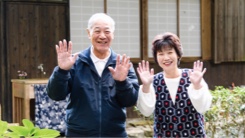
- Ujitawara-cho, a heart-shaped town southeast of Kyoto. Tea cultivation began in the Kamakura period (1185 to 1333), and the method of manufacturing green tea that became the basis of the way tea is made today was born here in the middle of the Edo period (1603 to 1868). Ujitawara-cho is truly the birthplace of Japanese green tea. Since olden times, Ujitawara-cho has been a strategic point of traffic linking the Yamashiro region to Nara and Ōmi, and there are many historic sites in the area. This town with its rich nature and history, nurtured in the culture of tea, is like a hospitable cup of tea; a place where visitors can relax and recover their peace of mind.
- Green tea originated in Obukudani.
-
Green tea originated in Obukudani.
Ujitawara Town began tea cultivation in the Kamakura Period. It is said that the disciple of a noted priest, Myo-e, a reviver of the World Cultural Heritage Kozan-ji Temple, introduced the cultivation method in the Kamakura Period. The first tea seeds were planted at the interior of Obukudani located at the foot of the sacred Mt. Jubu. The tea cultivated at Obukudani, a suitable place for tea cultivation, is said to have become popular and was presented to the Shogunate and Imperial House at that time.
-
The birth of Japanese green tea
Currently, many people in Japan enjoy drinking green tea. In fact, green tea is said to have originated at Yuyadani district in Ujitawara Town. In the middle of the Edo Period, Soen Nagatani, a tea dealer from Yuyadani, developed a tea method over 15 years, finally delivering tea with superior color, taste, and smell. His success changed the crude brown tea that common people used to drink into delicious green tea. Soen travelled to Edo (Tokyo) and sold the green tea through the sales channel of a tea dealer, Kahei Yamamoto, who later opened Yamamotoyama Store. His tea was quickly heralded as the “Best in Japan” and stirred a new boom. This tea method is known as “Aosei Sencha Seiho” and serves as the foundation of modern Japanese green tea.
- The birth of Japanese green tea
- Recognized as“ Japan Heritage”
-
Recognized as“ Japan Heritage”
Yuyadani’s tea industry flourished thanks to the popularity of Soen’s sencha (common green tea). While walking through the streets, lined with large tea wholesale stores and populated by tea farmers, visitors can imagine how this narrow area flourished at that time despite the fact that the small area is located along a valley. Soen’s home, which is located at the interior of Yuyadani, was also restored. There, visitors can see the remains of a tea dryer that Soen is said to have used. Yuyadani’s streetscapes, with his birthplace, tea plantations, tea dealers, and tea farmers, are recognized as “Japan Heritage.” (For details, please refer to the description at the bottom of this page.)
-
The tea industry is still alive in this town.
In Ujitawara Town, more than 100 tea farmers are still engaged in making superior tea. Tea events such as tea-picking, tea-tasting competitions, and tea-making events are held mainly in the fresh-tea season. Furthermore, the town is disseminating attractive information associated with tea, such as information on sweets that utilize tea in their ingredients. With pride as a town of tea in mind, Ujitawara Town has inherited a fruitful history and culture.
- The tea industry is still alive in this town.
What is“ Japan Heritage”?
The Agency for Cultural Affairs recognizes the narratives with regional attractive features that represent Japan’ s cultural and traditional properties. Regional areas take initiatives to maintain and utilize such integral cultural properties (regardless of whether tangible or intangible) and disseminate such information both inside and outside Japan, aiming to revitalize local areas. “A Historical Walk Through 800 Years of Japanese Tea” (Kyoto Prefecture), of which the narratives of Yuyadani in Ujitawara Town are part, was recognized as the first “Japan Heritage” offering, in April 2015.




